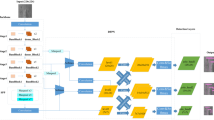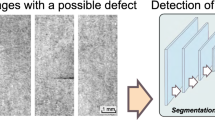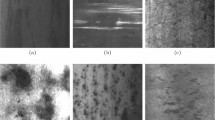Abstract
In modern engineering, weld joint excellence achieved through competent and on-line welding imperfections monitoring techniques. Online weld joint examination by non-destructive testing significantly demanded in vehicle, railways, aerospace, petrochemical, oil, gas, land transportation, shipbuilding, and marine industries. These industries demanded weld imperfection inspection as major part of their testing as physical inspection may confuse for appropriate justifications and lead to incorrect identifications. Hence, for error free examination automatic weld, this work proposed an autonomous technique for multi class weld imperfections namely crack, undercut, gas pores, porosity, slag, warm holes, lack of penetration and non defects are detected and classified in X- ray images by employing support vector machine and artificial neural network and confirm their high-performance accuracy. The proposed methods incorporated mainly four modules. In the first module weld image preprocess by median filtering to achieve protective edge of weld image by suppressing noises and by rectangular shaped histogram for dispersal grey levels to wider range with a brightness gradient achieved. Furthermore, second module propose canny edge operator to achieved complete and more continues edge of weld defect as compared to other edge operators. In the third module, ten texture feature extracted by grey level co-occurrence matrix. Moreover, cluster of signifiers identical to texture features measurements extract separated entity and stated as an input classifier. Finally for speedy advances of weld imperfection detection mechanization, support vector machine and artificial neural network detected and classified weld imperfections and confirmed their accuracy performance of 98.75 and 97.5% by confusion matrix. The autonomous technique for detection and classification of X-ray images reveals ideal calculation time without disturbing complete accuracy of features selection and presented comprehensive innovative technique with improved results.



























Similar content being viewed by others
References
Malarvel, M., Singh, H.: An autonomous technique for weld defects detection and classification using multi-class support vector machine in X-ray. Optik (2021). https://doi.org/10.1016/j.ijleo.2021.166342
Yang, L., Jiang, H.: Weld defect classification in X-ray images using unified deep neural network with multi-level features. J. Intell. Manuf. (2021). https://doi.org/10.1007/s10845-020-01581-2
Patil, R., Reddy, Y.: Multi-class weld defect detection and classification by support vector machine and artificial neural network. Smart Innov. Sys. Tech. (2021). https://doi.org/10.1007/978-981-15-9829-6_33
Kumar, G.S., Natarajan, U., Ananthan, S.: Vision inspection system for the identification and classification of defects in MIG welding joints. Int J. Adv. Manu. Tech. (2014). https://doi.org/10.1007/s00170-011-3770-z
Patil, R., Reddy, Y.: Weld imperfection classification by texture features extraction and local binary pattern. Smart Innov. Sys. Tech. (2021). https://doi.org/10.1007/978-981-15-9829-6_28
Li, Y., Gao, W.: Research on X-ray welding image defect detection based on convolution neural network. IOP Conf. Ser. J. Phys. (2019). https://doi.org/10.1088/1742-6596/1237/3/032005
Wenhui, H., Ye, W., Jie, G., Yi, J., Changan, Z.: Automatic detection of welding defects using deep neural network. Ser. J. Phys, IOP Conf (2018). https://doi.org/10.1088/1742-6596/933/1/012006
Weilei, M., Jianmin, G., Hongquan, J., Zhao, W., Fumin, C., Changying, D.: Automatic classification approach to weld defects based on PCA and SVM. Defect Classif Insight (2013). https://doi.org/10.1784/insi.2012.55.10.535
Zahran, O., Kasban, H., El-Kordy, M., AbdEl-Samie, F.E.: Automatic weld defect identification from X-ray images. NDT&E International (2013). https://doi.org/10.1016/j.ndteint.2012.11.005
Kumar, G.S., Natarajan, U., Veerarajan, T., Ananthan, S.S.: Quality level assessment for imperfections in GMAW. Weld. J. 93(3), 85–97 (2014)
Juan, Z., Rafael, V., Ramon, R.: An adaptive-network-based fuzzy inference system for classification of welding defects. NDT&E Int. (2010). https://doi.org/10.1016/j.ndteint.2009.11.002
Jiaxin, S., Han, S., Dong D., Li, W., Huayong, C.: Automatic weld defect detection in real-time x- ray images based on support vector machine, 4th international congress on image and signal processing. (2011). https://doi.org/10.1109/CISP.2011.6100637
Haihong, P., Zaijun, P., Yaowei, W., Yijue, W., Lin, C.: A new image recognition and classification method combining transfer learning algorithm and mobile net model for welding defects. IEEE Access (2020). https://doi.org/10.1109/ACCESS.2020.3005450
Sangjin, O., Minjae, J., Chaeog, L., Sung, A.: automatic detection of welding defects using faster R- CNN. App. Sci. (2020). https://doi.org/10.3390/app10238629
Dima, Y., Essa, A., Yuegang, T., Hong, L.: Enhancement in quality estimation of resistance spot welding using vision system and fuzzy support vector machine. Symmetry 12(8), 1380 (2020). https://doi.org/10.3390/sym12081380
Seungmin, S., Chengnan, J., Jiyoung, Y., Sehun, R.: Real-time detection of weld defects for automated welding process base on deep neural network. Metals (2020). https://doi.org/10.3390/met10030389
Ioannis, V., Dimitrios, K.: Multiclass defect detection and classification in weld X-ray images using geometric and texture features. Exp. Sys App. (2010). https://doi.org/10.1016/j.eswa.2010.04.082
Mohamed, S., Imbaby, I.M.: Classification of welding flaws in gamma x-rays based on multi—scale wavelet packet feature extraction using support vector machine. J. Nondestr. Eval. (2015). https://doi.org/10.1007/s10921-015-0305-9
Yuan, C., Hong, W.M., Guang, M.Z.: A support vector machine approach for classification of welding defects from ultrasonic signals. Nondestruct. Test Eva. (2014). https://doi.org/10.1080/10589759.2014.914210
José, A., Gabriel, C., Adilson, R., Milton, S., Filipe, A., Gustavo, M.: Discontinuity detection in the shield metal arc welding process. Sensors (2017). https://doi.org/10.3390/s17051082
Haodong, Z., Zuzhi C., Chaoqun Z., Juntong X., Xinyi L.: Weld defect detection based on deep learning method. IEEE 15th Int Conf on Aut Sci and Eng. (2019). https://doi.org/10.1109/COASE.2019.8842998
Muhtadan, R.H., Widyawan, F.A.: Weld defect classification in radiographic film using statistical texture and support vector machine. Adv. Mat. Res. 896, 695 (2014)
Celia, C.B.F., Tania, M., C., Myriam, R.: A deep artificial immune system to detect weld defects in DWDI x-ray images of petroleum pipes. IEEE Access (2019). https://doi.org/10.1109/ACCESS.2019.2959810
Yuanhang, C., Bo, C., Yongzhen, Y., Caiwang, T., Jicai, F.: A spectroscopic method based on support vector machine and artificial neural network for fiber laser welding defects detection and classification. NDT&E Int. (2019). https://doi.org/10.1016/j.ndteint.2019.102176
Qingming, S., Jianmin, G., Cheng, L.: Automatic classification of weld defects in X-ray images insight. Non-Dest. Test Cond. Mon. (2010). https://doi.org/10.1784/insi.2010.52.3.134
Baniukiewicz, P.: automated defect recognition and identification in digital radiography. J. Nondest Eval. (2014). https://doi.org/10.1007/s10921-013-0216-6
Dong, S., Sun, X., Xie, S., Wang, M.: Automatic defect identification technology of digital image of pipeline weld. Nat. Gas. Ind. B. (2019). https://doi.org/10.1016/j.ngib.2019.01.016
Hongquan, J., Yalin, Z., Jianmin, G., Zhao, W.: Weld defect classification based on texture features and principal component analysis. Defect Class Insight (2016). https://doi.org/10.1784/insi.2016.58.4.194
Author information
Authors and Affiliations
Corresponding author
Additional information
Publisher's Note
Springer Nature remains neutral with regard to jurisdictional claims in published maps and institutional affiliations.
Rights and permissions
About this article
Cite this article
Patil, R.V., Reddy, Y.P. An Autonomous Technique for Multi Class Weld Imperfections Detection and Classification by Support Vector Machine. J Nondestruct Eval 40, 76 (2021). https://doi.org/10.1007/s10921-021-00801-w
Received:
Accepted:
Published:
DOI: https://doi.org/10.1007/s10921-021-00801-w




